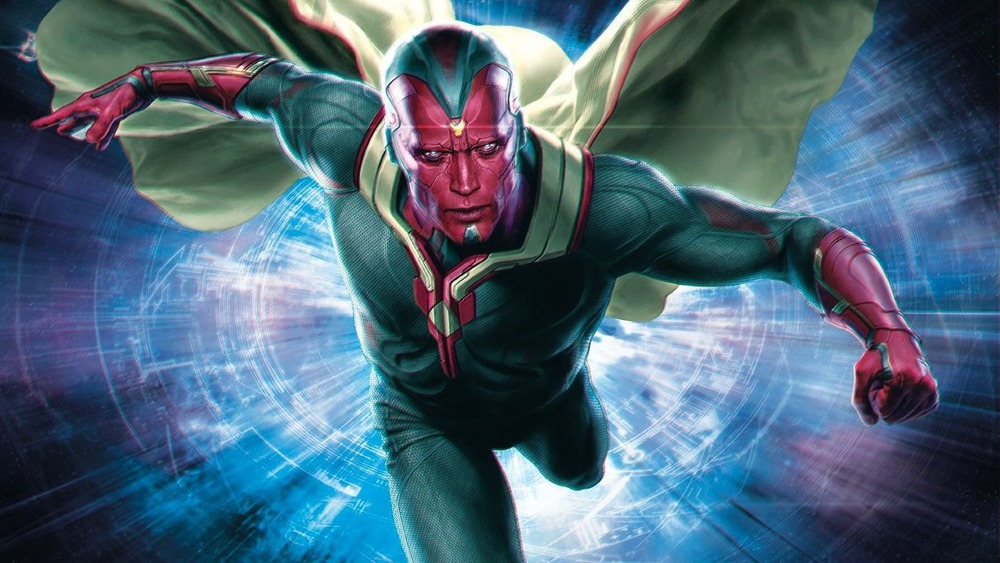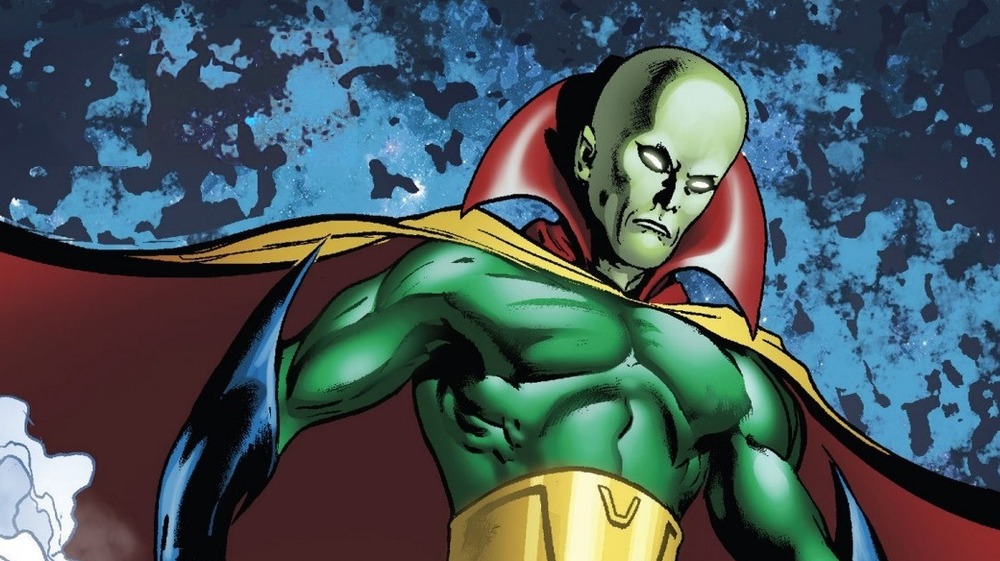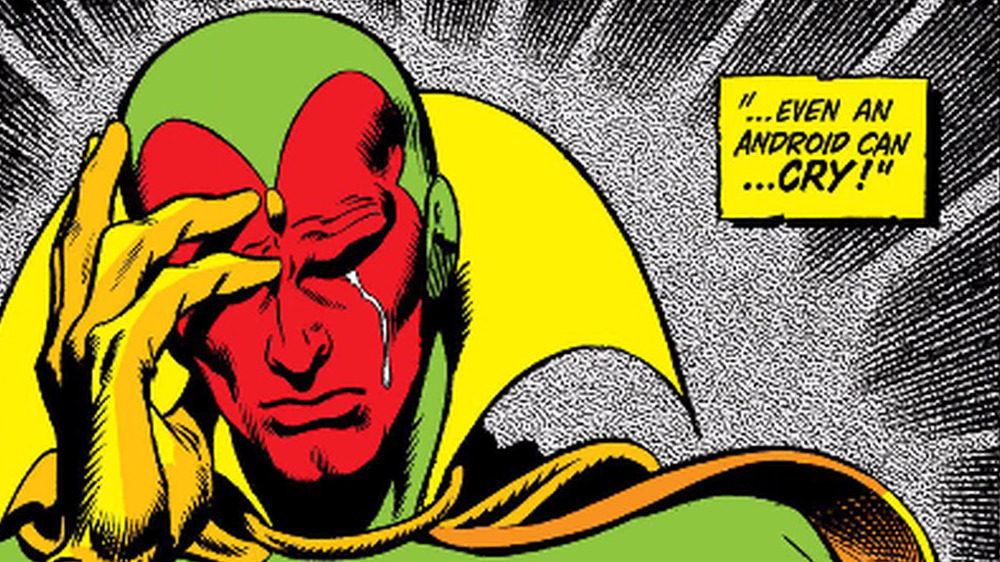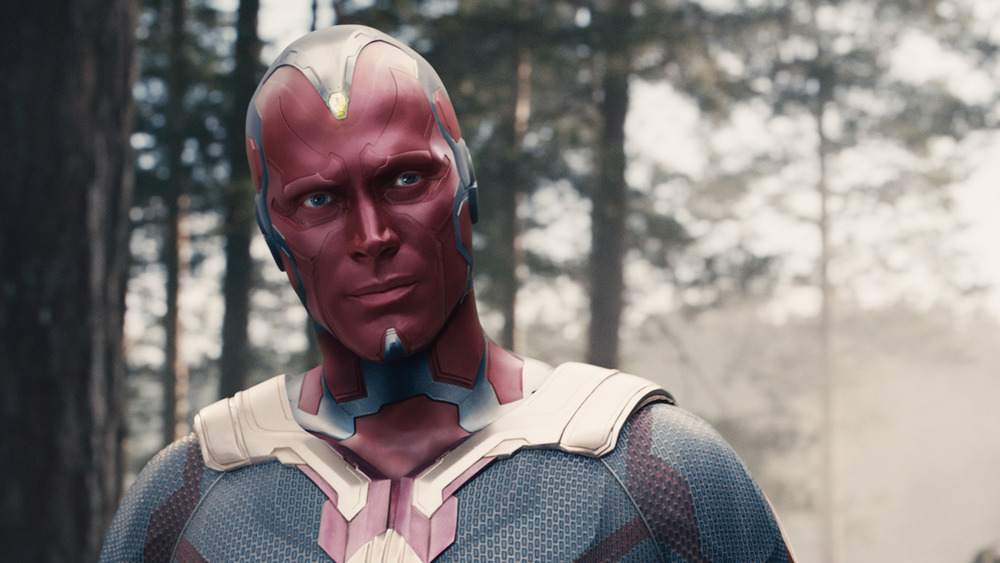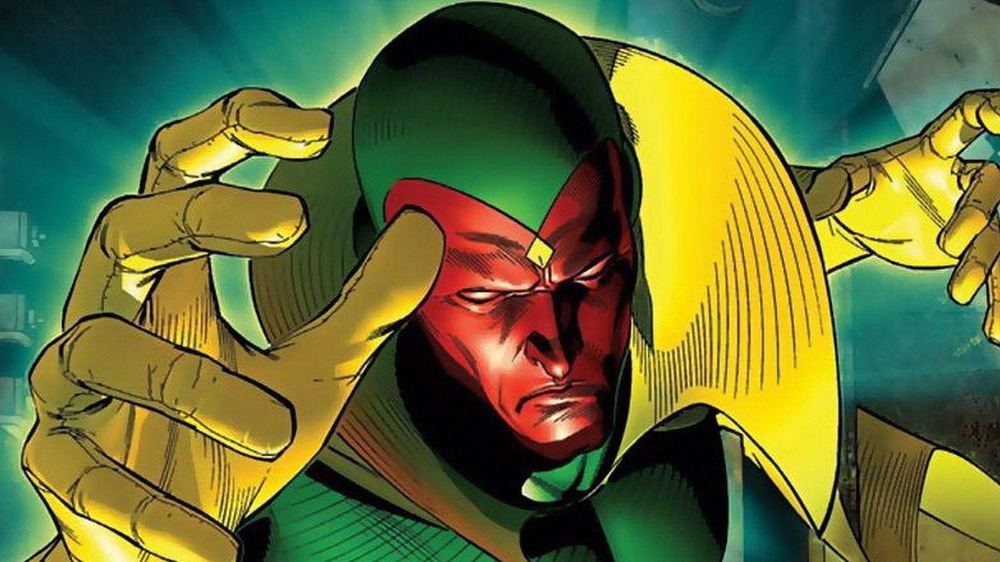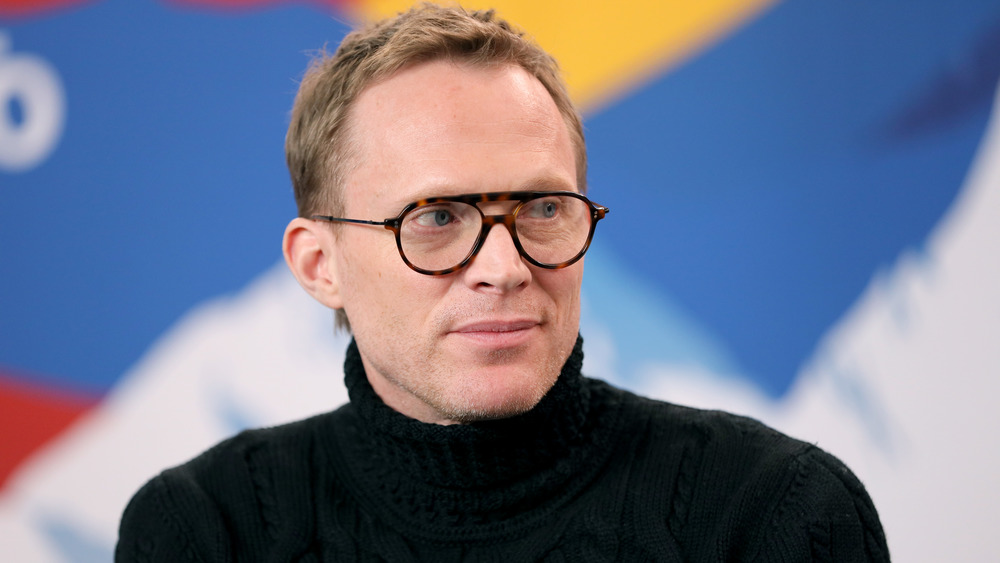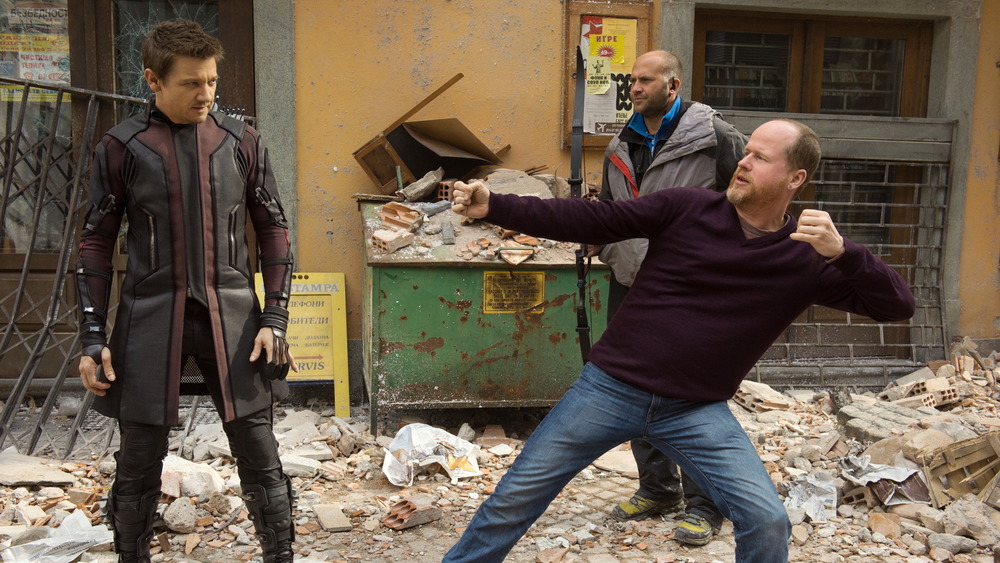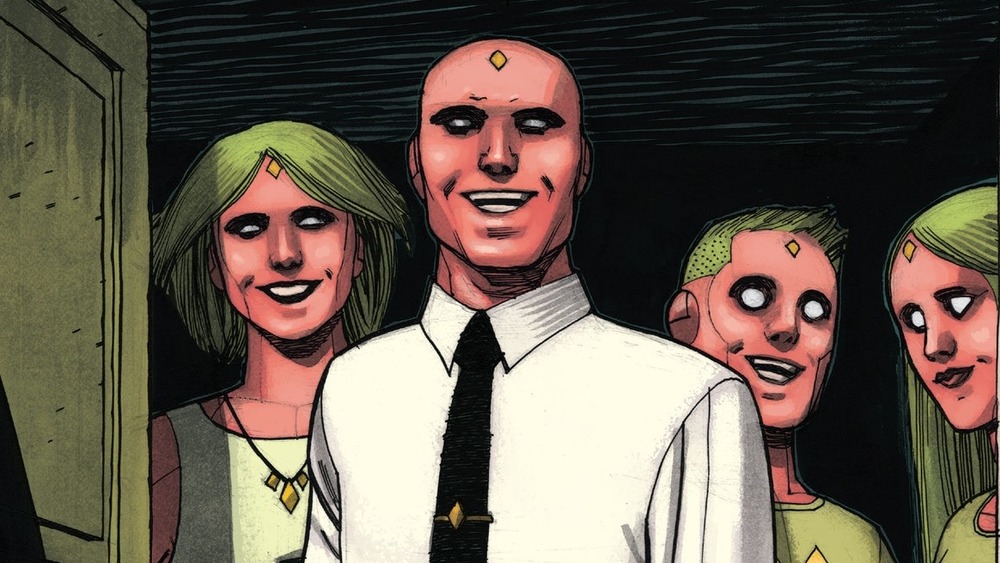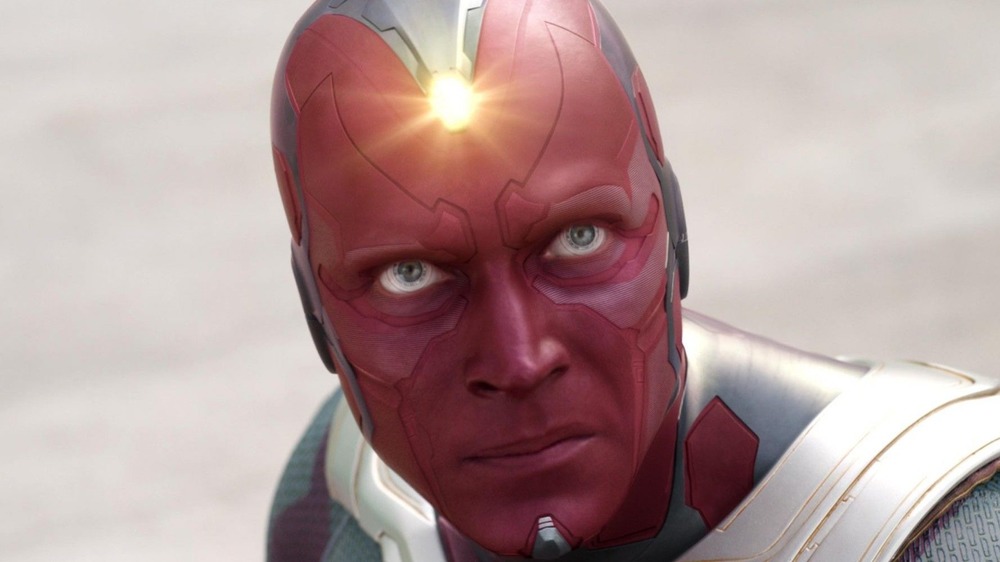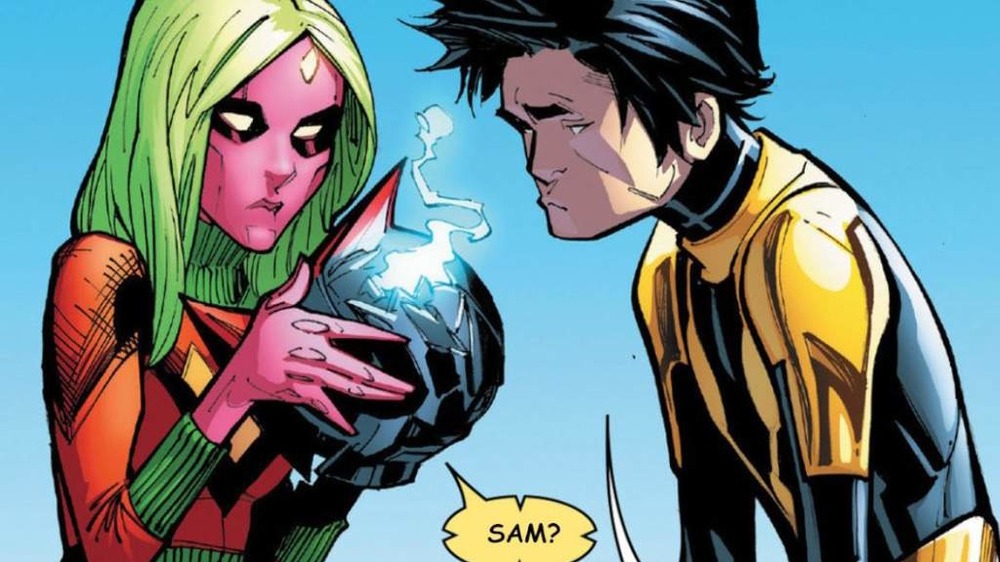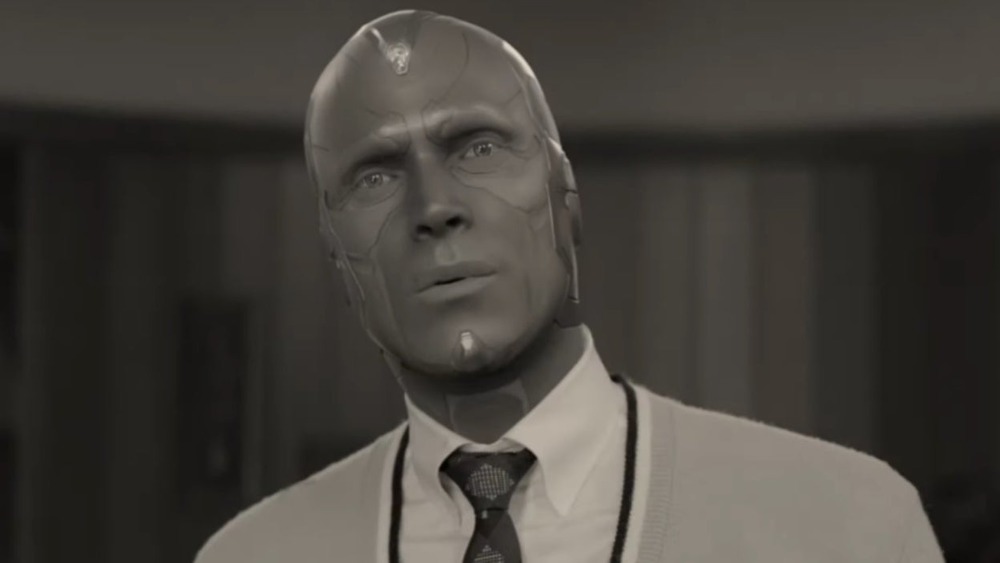The Untold Truth Of Vision
"Behold ... the Vision!"
With that dynamic text splashed across the cover of 1968's Avengers #57, a new Marvel superhero arrived in the form of Vision. A creation of Roy Thomas and John Buscema, Vision starts out as an antagonistic figure built to help the villain Ultron, before he reforms and becomes a stalwart member of the Avengers. In the decades since his explosive debut, Vision has had a wide array of adventures in the Marvel universe that have included everything from fighting fiendish aliens to marrying fellow Avenger Scarlet Witch. The character has proven to be such an enduing and beloved staple of Marvel Comics that it was inevitable he would make his way into other media. Over the years, Vision has managed to appear in a slew of TV cartoons and video games, while a live-action version of the character played by Paul Bettany has factored heavily into the Marvel Cinematic Universe.
In light of the popularity of WandaVision, Vision has never been more prominent in the pop culture landscape. Even with that increased interest, however, there are still plenty of little-known aspects of the character, such as his Golden Age predecessor and the character's impact on Paul Bettany's career. Just as a heroic Avenger hid within Ultron's android lackey, so too are there countless untold truths nestled within Vision's history. Let's take a closer look at them.
He's not the first Vision in Marvel Comics history
Vision may be the most popular character with that name in the Marvel universe, but he sure wasn't the first to claim the moniker. Decades before that Vision would first leap onto comic pages, a totally different character named Vision appeared in 1940's Marvel Mystery Comics #13. Also operating under the name Aarkus, this Vision is an alien who has teleportation and ice-based superpowers. He fights alongside superheroes like the Human Torch and Namor as part of the Invaders, an early Marvel superhero team. In the 1960s, a number of these classic Golden Age characters, including Captain America and Namor, came back into the spotlight. Vision (Aarkus), however, was not lucky enough to receive this treatment. Though comics writer Roy Writer initially wanted to revive Aarkus for the 1960s, company mandates forced him to create a new character for the name Vision to be applied to instead. Thus, the very first Vision in Marvel Comics history quickly faded into obscurity.
However, that doesn't mean this early Vision has been totally forgotten. Since the 1970s, Vision (Aarkus) has managed to make a handful of appearances in the comics, including a 2013 X-Men: Legacy storyline. Most recently, he managed to become a playable character in the mobile video game Marvel Contest of Champions.
Vision was originally a different color
Some superheroes like to dress exclusively in bleak colors. Not so for Vision: This particular Avenger is readily identifiable by his head-to-toe bold colors. A bright yellow cape and gloves compliment Vision's green body and red face — he's easy to spot in any crowd. However, choosing such hues wasn't an easy task. "I didn't want to make him green like the Hulk or blue like the Atlanteans," creator Roy Thomas explained to The Hollywood Reporter. "I suppose I could have made him white, but the paper we printed on was so poor, that you would have been able to see the other side, so we didn't make things white that we didn't have to."
In addition to the technological limitations affecting Vision's design, there was also internal controversy to be dealt with: Marvel legend Stan Lee wasn't a fan of Vision's look. "Stan hated the color of the Vision," Thomas recalled in the same interview. "'Why'd you make him red? Red's not a good color!'" Though neither Thomas nor Lee were initially satisfied with Vision's colors, it's those same hues that have made him one of the most visually distinctive Marvel superheroes around.
Stan Lee wanted Vision to be an android
Sometimes, iconic characters come about due to spur-of-the-moment creative inspiration. Others, like Vision, come out of something as simple as a mandate from the boss. According to Vision's creator, Roy Thomas, Vision was created as a solution to Stan Lee's mandate for new Avengers members. "Stan suddenly said it was time to make up a new character, to bring in a new Avenger," Thomas explained to Yahoo. "I didn't like to create new characters for Marvel, because I wouldn't own them. I wanted to bring back the old Vision ... But Stan wanted an android. He didn't say why. He just said he wanted the new character to be an android. Stan says, 'Create a new Avenger.' I didn't argue with him." Thus, the Vision the world knows and loves was born, all thanks to Stan Lee's insistence on an android Avenger.
It may not be the glossiest origin story for an iconic superhero, but Lee's mandate did have its advantages. Chiefly, it immediately helped make Vision stand out on any Avengers roster — and still does, in fact. The distinguished superhero team has had all kinds of unusual members, including giant green monsters, billionaires in iron suits, and men who can shrink at will. Yet even in that unorthodox crowd, an android like Vision manages to catch readers' attention. Right from his conception, Vision was a unique (if a bit cynically produced) creation.
Vision has frequently been compared to Spock
In the 50-plus years he's existed, Vision has often drawn comparisons to Star Trek's Spock. It isn't hard to see why. On the surface, there's the fact that they're both sci-fi characters introduced in the late 1960s. On a deeper, more specific level, they're both no-nonsense figures who are usually the only non-humanoid members of their group. While these similarities are glaring, Vision's creator has maintained that this colorful android is no Vulcan rip-off.
"People have told me they see a resemblance to Mr. Spock," Vision creator Roy Thomas said. "If there is, I didn't do it consciously. I was vaguely aware of the show. We would play poker while our wives and kids sat in the next room watching Star Trek. So I would hear the TV playing." Rather than using Spock as a model, Thomas actually drew inspiration from a robot named Adam Link in Otto Binder's short story, "I, Robot." In this tale, which also inspired Isaac Asimov's book of the same name, Link is falsely accused of murdering his creator. In the ensuring chaos, Link becomes all too aware of the adverse effects his very existence has on human beings, who are immediately suspicious of a robot. Adam Link's tragically self-conscious qualities are immediately apparent in Vision, in addition to the character's unintentional overlap with Mr. Spock.
Vision's actor was originally J.A.R.V.I.S.
In the Marvel Cinematic Universe, Vision is played by actor Paul Bettany. Prior to his multi-film turn as Vision, Bettany appeared in a wide variety of movies, ranging from Master and Commander: Far Side of the World to Priest. Among those acting credits was an earlier role in the MCU as Tony Stark's A.I. helper, J.A.R.V.I.S. A reimagining of the comics' Edwin Jarvis, who is a human butler, J.A.R.V.I.S. was not a role that Bettany initially put much stock in. At the time of Iron Man's release, Bettany said that while he was recording his voicework for J.A.R.V.I.S., "I didn't know I was in a superhero movie. I made a movie with Jon Favreau before and he rung me up and said, 'Paul...' ... I said, 'Yeah, alright.' I genuinely didn't know. I'm really naïve, but it's the f**king truth." The greatest example of Bettany's detachment from the project? At the time of this interview, Bettany still hadn't actually seen Iron Man.
While Bettany started out as an outsider oblivious to the larger machinations of the Marvel Cinematic Universe, he didn't remain that way for long. After playing J.A.R.V.I.S. across four different MCU installments, it was announced in February 2014 that Bettany would be taking on a physical role in the MCU as Vision. In addition to his many surreal superpowers, Vision also apparently has the ability to help people secure multiple roles in the Marvel Cinematic Universe.
Joss Whedon always wanted to use Vision in Avengers: Age of Ultron
When Joss Whedon was putting together his ideas for Avengers: Age of Ultron, he intended to use the mammoth box office success of the original Avengers to realize some of his grander (and nerdier) ambitions. He aimed to utilize a wider variety of superpowers, explore some darker emotions, and use Ultron as the primary villain. Also right there from the get-go was the audacious idea to utilize Vision, and have the character played by Paul Bettany.
Like many of Whedon's plans for Age of Ultron, this was a notion he had carried with him long before the cameras even started rolling on the first Avengers movie. "Before I took the first [Avengers]," Whedon explained, "I said, 'Well, I don't know if I'm right for this or if I want it or you want me, but in the second one, the villain has Ultron and he has to create the Vision, and then, that has to be Paul Bettany.'" Whedon went on to note that his fascination with the character derives from Vision's unusual power set, as well as the fact that Vision was a focal point of the comics he grew up reading. As for his longstanding dream of having Bettany inhabit the role, the director joked that Bettany's sharp cheekbones make him a natural fit for the part.
Vision has rarely been a solo act in the comics
Though he's existed for over half a century in the Marvel Comics canon, Vision has usually acted as a supporting player. First introduced in the comics as a creation of Ultron who is convinced to fight back against his creator, Vision subsequently became a fixture of the Avengers comic books. Over the years, Vision has factored prominently into the Avengers' adventures — the wedding between himself and Scarlet Witch even acts as the centerpiece of Giant-Size Avengers #4. Still, being a standout member of an ensemble is not the same thing as headlining your own comic series, a feat that most other Marvel superheroes have been able to do regularly.
While Vision has been a supporting player for most of his fictional life, he's still played a major role in numerous storylines that have shaped the Marvel universe. Moreover, the character has managed to secure a handful of solo adventures over the years. The first of these was a four-issue Vision series published in 1994 by Bob Harras and Manny Clark. More recent, and perhaps more notable, is 2015's 12-issue Vision series by Tom King and Gabriel Hernandez Walta. This particular run inspired widespread praise, and was even dubbed by many outlets as one of the best comics of the entire year. Even if Vision isn't a go-to figure for headlining Marvel comic books, these acclaimed stories starring the mysterious character show the value Vision has as a leading man.
Vision's makeup was a tough nut to crack
If you're going to be a superhero in the Marvel Cinematic Universe, you're going to have to put on an elaborate costume. Sometimes, this costume is the motion-capture suit Mark Ruffalo has to wear to portray the Hulk. Other times, it's the patriotic get-up Chris Evans had to pull on to portray the Star-Spangled Man with a Plan. In the case of Paul Bettany, properly portraying Vision means having to undergo extensive application of makeup and subtle prosthetics. Transforming Bettany into the boldly-colored Vision is not an easy task: A two-hour process is required to make the man into the machine. Vision's makeup proved to be time-consuming even before the cameras started rolling, in fact, as the makeup artists for Age of Ultron, in which Vision makes his MCU debut, were utterly determined to get the character's unique look painstakingly right.
"The make-up went through a lot of stages," reflected makeup artist Nik Williams in 2015. "In order to make the lines absolutely perfect, as though he was born from a computer, we actually 'sculpted' the make-up in 3-D over a cyber-scan of Paul's head and printed out in clear plastic." While Vision's look wasn't easy to put together, all this exacting effort certainly paid off. Vision came to the silver screen looking both visually pleasing on his own merits and like he'd walked straight out of the Marvel comic books in which he was born. That takes superheroic skill.
New visions of the character in the comics
Vison isn't the first character to carry that moniker in the comics, so it should be no surprise that he's also not the last character to bear the name. Whereas the Vision created in 1967 is a massive departure from the one created in the 1940s, though, the newest superheroes to carry on the Vision name have been directly inspired by the crimson-colored android.
In 2005, a new version of Vision debuted in Young Avengers #5. While he looks like a dead-ringer for the original Vision, this new hero is younger and goes by the name Jonas. Speaking of newer and younger versions of Vision, the mainstream Vision's most notable superhero successor emerged in the form of his own daughter, Viv Vision. First appearing in Tom King and Gabriel Hernandez Walta's Vision #1, the character starts out as one part of Vision's fragmented attempt to create a traditional American nuclear family for himself. In the years since that run, Viv has blossomed into a standalone superhero in her own right. While Viv boasts her dad's superpowers, she also has unique traits of her own. Furthermore, she is one of Marvel's few openly LGBTQ+ superheroes.
For over 80 years now, Marvel Comics has made use of superheroes named Vision. With new characters like Jonas and Viv Vision, it's clear that this long and complex legacy will be utilized for many decades to come, in fantastic new adventures.
Vision was a turning point for Paul Bettany's career
In his time as a superhero, Vision has saved numerous people. Among the many he's saved is Paul Bettany himself. In a 2018 interview, Bettany revealed that the chance to portray Vision in the Marvel Cinematic Universe came just as it looked like his acting opportunities were about to dry up. "I had just had a meeting with a producer, who will remain nameless, who told me that my career was over. He said 'You're done, you're done in this town,'" Bettany recalled. Briefly, the actor was gripped with despair, before getting a phone call from Age of Ultron director Joss Whedon. Whedon proceeded to ask if Bettany wanted to play Vision in the then-upcoming Avengers sequel. That one phone call turned things around for Bettany completely.
As Bettany reflected, "I sort of looked up to heaven and thought karma's very quick these days ... It happened just like that. I sat down and my phone rang. Very funny. But you know if I had a dollar for every time somebody told me my career was over, my career could be over." Since then, Bettany has portrayed Vision in a number of MCU titles, and the franchise's first Disney+ series, WandaVision. Beyond the MCU, Bettany has also landed roles in films like Solo: A Star Wars Story and Uncle Frank. Clearly, whoever said Bettany's career was over didn't have the best vision when it comes to the actor's impressive prospects.
